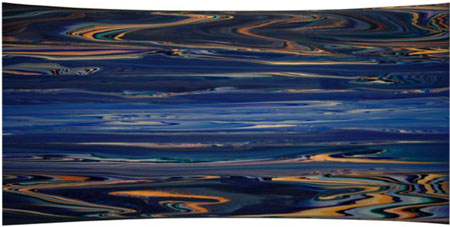
Andy Moses bridges multiple genres with his horizontal, semi-curved abstract compositions. Landscapes mixed with minimalism and post-painterly abstraction equates refined and stylized paintings that provoke many questions. This series of recent works reward the viewer who exercises patience and knowledge of the natural world.
“Te Rangi” is typical of Moses’ work. It is a large horizontal canvas that seems to stretch out towards the edges of the room. This effect is magnified by what he calls a hyper-parabolic concave canvas. Similar in shape to Cinerama screens from the 1950s, whose multiple modules were intended to intensify moviegoers’ experience of the projected film, Moses wants his concave canvases to envelop the peripheral vision of the viewer. The curve also changes the way a viewer interacts with the piece. As one shifts one’s vantage point, light and motion alter perception of the painting. It would be a stretch to call these canvases sculpture, but they do extend forward into the gallery space.
The content of Moses’ paintings is not readily apparent upon first look. Abstract landscapes? Yes, perhaps they are, but Moses’ investigation and interest in the natural world appears to be rooted primarily in his imagination, though he does reference actual locations. Formally considered, “Permian Basin” is drenched in an effervescent series of rose, pink, and maroon colors that combine to form an aerial landscape. One can almost imagine the crust of the coast falling into the body of water below. The painting has an otherworldly feeling, as recognizable forms morph into pools of an unknown substance that is like oil and water mixing. The title, “Permian Basin,” refers to a few particular areas in the world where the earth contains large structural foundations of rocks that date from roughly 250 million years ago. The age of these regions complements the unusual coloring and the mystical abstraction, and the related painting hovers between a careful reconstruction and playful imagination.
There are basic foundational elements that form the premises to this body of work. The horizontal shape, size, and paint treatment are systematic. However, the color scheme and abstract subject matter shift to evoke varied locales and experiences. “Aqaba” is representative of this flux. The painting is significantly lighter than the other works on display. The sand colored image refers to a coastal town in Jordan that has access to the Red Sea. This link to water is a common reference in Moses’ work, as blues of varying shades work their way into many of the pieces. In “Aqaba” the blue shapes form small pools along the bottom half of the painting and become less distinguishable as they recede toward the horizon line located in the center of the image. The top half of the painting or what we could consider the sky, does not consistently mirror the forms below. Instead, the colors blend together in a few areas so as to suggest the effect when moisture and light interact. This refracted light, or rainbow, is further evidence of water throughout the image. This natural resource explains the otherwise mysterious and sensuously organic shapes that swirl through the majority of Moses’ images.
Each of the locations referenced in the titles could be a picturesque site in their own right. They are exotic and certainly natural, that is, with little indication of cities or other human infrastructure. These locations combined with Moses’ use of abstraction recall the methods of a certain landscape painter of the 19th century who also favored the use of light and color. The English artist J.M.W. Turner often utilized a quasi-abstract painterly technique to produce romantic landscapes where color blurred the recognizable features of the subject. Moses’ “Uncompahgre” is reminiscent of this romantic tension. The title derives its name from a river and forest in Colorado. The faint outline of the river is present, but gradually becomes less distinguishable as the forms moving outward from its banks resemble layers of sediment. Whether or not this is an effort to depict the river’s age and erosion over time is beside the point. The drama lies in how the painting’s abstract nature wrestles to become the subject.
The importance of the landscape and the way water and light interact are clearly significant features in Moses’ work. Because of the unusual shape of the canvas and the glossy glass-like surface, the referenced subject matter is less definable and more open to a formal interpretation. Moses’ technique of applying paint struggles with the imagery for primary attention. Yet there is a consistent hint of the horizon that provides a hook by which to delve into this hybrid of abstraction and landscape.
Published courtesy of ArtSceneCal ©2010
